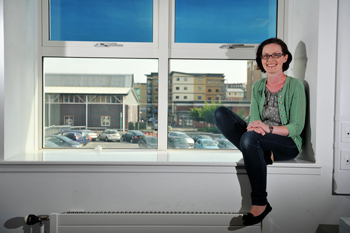Sunlight control at the touch of a button
18th September 2012
 |
An advanced electronic glazing system that darkens windows at the touch of a button and has the potential to revolutionise building façade design is being tested in offices at De Montfort University (DMU).
The windows - manufactured by SAGE Electrochromics Inc in the US - have a special ceramic coating which can vary the level of tint when a small electric voltage is applied. Electrochromic glazing has the potential to dramatically alter the way we use glass in architecture, reducing the need for blinds or external shading devices without compromising occupant comfort or the energy performance of the building.
DMU has installed the windows in two offices at the university where the system will be studied in a normal working environment. This is the first commercial building in the UK to have electrochromic glazing installed, and is one of the first in Europe in continuously occupied ‘typical’ office spaces. The data gathered by DMU scientists from its Institute of Energy and Sustainable Development (IESD) will be a key study in the evaluation of this novel technology.
IESD researchers will study various aspects of the system in use, including the ability of the windows to control direct sunlight and bright skies to improve the comfort of occupants. They will also examine the effects of the system on the use of air conditioning during warm periods, and the users’ experience of the technology and user interface.
Dr Birgit Painter of the IESD who is co-ordinating the project, said: “This research project is the first to study electrochromic glazing in a typical work environment over an extended period of time.”
“Window blinds that are typically used to control daylight are often left down so that occupants lose the benefits of daylight and views - this is known as “blinds down, lights on” syndrome. Electrochromic glazing could address this issue, as well as reducing reliance on electric lighting and air conditioning. The windows can be controlled manually or automatically, with the control settings tailored to the application. And unlike blinds, the glazing still gives the occupants a view outside.
Ruth Kelly, a PhD student working on the project, added: “Electrochromic windows could be retrofitted to many types of building with large areas of glazing, including offices, schools, and hospitals, which suffer from glare and overheating. Studies have shown that electrochromic glazing could save 23% on daily electricity usage for lighting.”
|
